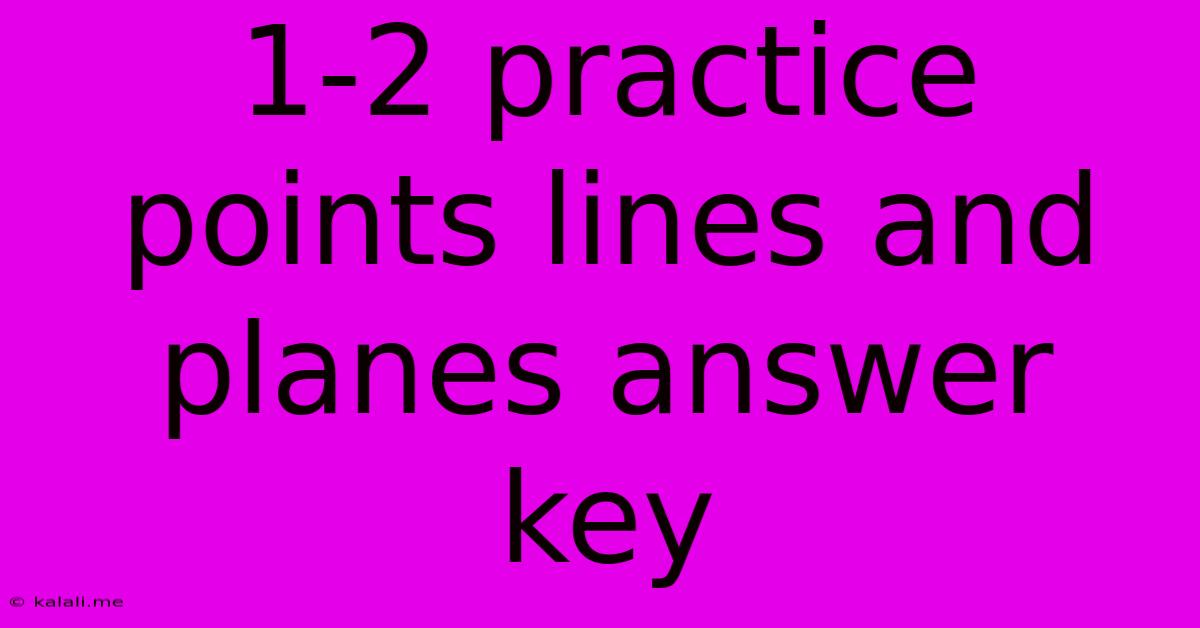1-2 Practice Points Lines And Planes Answer Key
Kalali
May 10, 2025 · 3 min read

Table of Contents
1-2 Practice: Lines and Planes – Answer Key & Explanations
This article provides a comprehensive answer key and detailed explanations for a hypothetical "1-2 Practice" worksheet focusing on lines and planes in geometry. Since the specific questions aren't provided, I'll cover common problems encountered when dealing with lines and planes, offering example solutions that can be adapted to your specific practice problems. This will help you understand the underlying concepts and improve your problem-solving skills.
Meta Description: Learn how to solve common geometry problems involving lines and planes with this detailed answer key and explanation guide. Master concepts like parallel lines, intersecting planes, and more.
Understanding Lines and Planes
Before diving into the answer key, let's review some fundamental definitions:
- Line: A one-dimensional object extending infinitely in both directions. It's defined by two points or a point and a direction.
- Plane: A two-dimensional flat surface extending infinitely in all directions. It can be defined by three non-collinear points.
- Parallel Lines: Two lines that lie in the same plane and never intersect.
- Intersecting Lines: Two lines that share a common point.
- Parallel Planes: Two planes that never intersect.
- Intersecting Planes: Two planes that intersect in a line.
- Skew Lines: Two lines that are not parallel and do not intersect (they are not in the same plane).
Example Problems and Solutions
Let's tackle some typical problems and their solutions. Remember to replace these examples with your actual practice problems.
Example 1: Identifying Parallel and Intersecting Lines
Problem: Given lines l and m in a plane, determine if they are parallel or intersecting. Line l passes through points A(1,2) and B(3,4). Line m passes through points C(2,1) and D(4,3).
Solution: Find the slopes of both lines. The slope of line l is (4-2)/(3-1) = 1. The slope of line m is (3-1)/(4-2) = 1. Since the slopes are equal, lines l and m are parallel.
Example 2: Finding the Intersection of Two Planes
Problem: Find the line of intersection between plane P1: x + y + z = 6 and plane P2: x - y + 2z = 0.
Solution: This requires solving a system of two linear equations. One method is to express one variable (e.g., x) in terms of another (e.g., z) from one equation, and substitute into the other equation. Solving this system will give you a parametric equation representing the line of intersection. For example, from P2, x = y - 2z. Substituting this into P1 yields (y - 2z) + y + z = 6, simplifying to 2y - z = 6. Letting z = t (a parameter), we get y = (6 + t)/2 and x = (6 + t)/2 - 2t = (6 - 3t)/2. Therefore, the line of intersection can be represented parametrically as x = (6 - 3t)/2, y = (6 + t)/2, z = t.
Example 3: Determining if Lines are Skew
Problem: Determine if lines defined by points A(1,0,0), B(0,1,0) and C(0,0,1), D(1,1,1) are skew, parallel, or intersecting.
Solution: Find the direction vectors of the lines. The direction vector of AB is <-1,1,0> and the direction vector of CD is <1,1,1>. Since these vectors are not proportional (one is not a scalar multiple of the other), the lines are not parallel. To check for intersection, solve for parameters t and s in r(t) = <1-t,t,0> and q(s) = <s,s,s> that yield the same point. This leads to a system of three equations. If the system is consistent, the lines intersect; otherwise they are skew. Solving reveals no solution, therefore these lines are skew.
Further Practice and Resources
Remember to thoroughly understand the concepts of lines and planes before attempting more complex problems. Practice with various problems involving different scenarios (parallel lines, intersecting planes, skew lines) to build a strong foundation. Consult your textbook or online resources for additional problems and explanations if needed. Remember to always visualize the geometric relationships between lines and planes. This spatial reasoning will significantly enhance your problem-solving abilities.
Latest Posts
Latest Posts
-
Jaguar Adaptations In The Tropical Rainforest
May 10, 2025
-
How To Find Average Velocity From Velocity Time Graph
May 10, 2025
-
What Is Non Living Things In The Ecosystem
May 10, 2025
-
How Many Fl Oz In 6 Cups
May 10, 2025
-
What Is 1 Percent Of 5000
May 10, 2025
Related Post
Thank you for visiting our website which covers about 1-2 Practice Points Lines And Planes Answer Key . We hope the information provided has been useful to you. Feel free to contact us if you have any questions or need further assistance. See you next time and don't miss to bookmark.